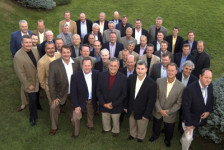Some Assembly Required
 For many ag retailers today, consolidation is a way of life. For Agrium Retail, however, consolidation is a way of doing business.
For many ag retailers today, consolidation is a way of life. For Agrium Retail, however, consolidation is a way of doing business.
“Our number one goal is always going to be to maximize our base business and keep improving on what we’ve done,” says Richard Gearheard, company president, of the operation’s business approach. “Number two, we are going to look to fill our existing markets where it makes sense through acquisitions. And number three, we want to be ready for any major acquisition that becomes available. With everything we’ve acquired recently now integrated, we think that we are ready to do that if it arises.”
Of course, among the “recent acquisitions” Gearheard is talking about is one of the largest retailer consolidations ever — purchasing the 250-plus outlets of Royster-Clark, Inc. in early 2006. The company followed this up with the acquisition of the agronomy division of ADM/Collingwood Grain in mid-2007, adding another 32 outlets to its total.
“We are always looking to grow,” says Gearheard. “It’s one of Agrium’s basic strategies, to increase our base business and make the earnings level more stable.”
Independently Joined
In truth, this basic business model dates back to the early days of the company in 1993, when Agrium first bought out its partners to become the sole owner of the then 10-year-old Crop Production Services (CPS). A few years later in 1995, Agrium acquired Western Farm Service (WFS), effectively giving the company retail footholds in both the Midwestern and Western states.
However, even though both retail organizations are owned by a single company, they still maintain their individual identities, mainly due to the vastly different market profiles they have to deal with. According to Gordon Miller, vice president for WFS, his portion of Agrium Retail gets 30% of its inputs business from vegetable grower-customers, with only a hint of corn (1.5 million acres) and no soybeans. “Overall, we have 300 different crops in our territory,” says Miller. By contrast, in the CPS territory, corn and soybeans are the major crops, accounting for better than 85% of inputs and services income.
Gearheard says that since the beginning, this dual retailer identity approach has worked well for Agrium Retail, and has not needed to be changed. “In the retail business, you are not dealing with multiple states out of one location,” he says. “You are dealing with a 25- to 40-mile radius, so it’s not confusing to a person in North Carolina what you call your operations in California.”
But that doesn’t mean CPS and WFS operate independently of one another when the good of Agrium Retail is at stake, says Gearheard. For example, in 1999, CPS entered into negotiations to acquire PureGro, a Western states-based ag retailer that directly competed with WFS in many markets. “Once the deal was complete, it was decided that those facilities that were in WFS’ territory would move over to its side of the business because it made more sense for our Western-based operation to run them than our Midwestern-based one,” he says.
Another such move was the shifting of responsibility for CPS’ Argentina retail operations, which were started back in 1995, to WFS during the early 2000s.
The Big One
According to Gearheard, a big test of this split corporate identity took place recently with the Royster-Clark acquisition. In mid-2005, Agrium Retail made a bid to purchase Royster-Clark. At the time, the company was one of the largest retailers in the country, with more than 250 outlets spread out across the East Coast, Midwest, and Southeast. Annual revenue for Royster-Clark was just shy of $1 billion, ranking the retailer No. 6 on the CropLife 100 listing of top retailers in the U.S. in 2005.
Royster-Clark’s owners were initially opposed to the takeover, but they eventually agreed to sell the company to Agrium Retail in February 2006. Overnight, this added 10 divisions to Agrium Retail’s company family.
Then came the fun part, says Gearheard — deciding what to do with the Royster-Clark assets. Royster-Clark’s territory was largely in areas that Agrium Retail’s CPS and WFS groups did not operate, and the company name was well established. The question was, should the Royster-Clark name be retained, giving Agrium Retail a third identity, or should it be incorporated into the CPS retail division mix?
“In the beginning, we were certainly open to leaving the Royster-Clark name in place, particularly in the Southeast and East where the company had a long history,” says Gearheard. Ultimately, he says, it was left up to the Royster-Clark employees themselves to decide. “When we asked the workers what we should do, they came back saying they wanted to make a change in direction with the new ownership in place, so a name change made the most sense to them,” says Gearheard.
Looking at both WFS and CPS, Gearheard says that the decision was made to fold the former Royster-Clark outlets into the CPS family. Today, he reports, the integration is proceeding on schedule, with all the old Royster-Clark facilities being rebranded with the CPS logo by the end of 2007. Due to territory overlap or age, he adds, 41 old Royster-Clark outlets were closed.
Of course, staying true to its general business philosophy, Agrium Retail hasn’t stood pat during the Royster-Clark integration process. Earlier this year, the company acquired the agronomy parts of 32 ADM/Collingwood Grain operations in Kansas and Oklahoma. “This acquisition was unique for two reasons,” says Gearheard. “For one thing, this gives us outlets in two states where we didn’t have a presence before. For another thing, we only purchased the agronomy side of the business from Archer Daniels Midland (ADM) at those locations. As for the grain operations at these facilities, these are still being managed by ADM.”
Unlike with the Royster-Clark deal, the former ADM/Collingwood Grain outlets were quickly integrated into the CPS system without much debate. “This integration is basically done, and was much easier than Royster-Clark’s because you are only talking about one division being added, not 10,” says Gearheard. Tom Warner, vice president of CPS, says that the addition of ADM to his company’s mix makes perfect sense, just like it did for Royster-Clark. “Royster-Clark and ADM were very similar companies to ours, both being very service focused,” says Warner. “The challenge for both has been how to up their service results. Royster-Clark didn’t have the money to do that and ADM was mainly focused on handling grain. Neither of these things are an issue with CPS.”
A Solid Second
With the assets of Royster-Clark and ADM/Collingwood Grain added to its mix, Agrium Retail has cemented its spot as the second largest ag retailer in the country. The company now boosts 431 outlets in 31 states and has annual revenue of more than $1 billion.
This bulk, however, has presented Gearheard with something of a dilemma. “I used to pride myself on the fact that I had personally visited every one of our retail locations before the Royster-Clark and ADM deals happened,” he says. “But now, I can’t say that anymore. I don’t know where every feather falls. I’ve got to get used to the fact that I haven’t been to all of our places. As busy as things are right now, I’m not sure I will ever get around to doing that.”
In terms of inputs, fertilizer represents 57% of the company’s income. As would be expected, the retailers get most of their crop nutrients from parent company Agrium. But Gearheard is quick to add that the locations are not pampered in the process.
“Agrium treats the retail group at arm’s length,” he says. “We buy products from them just as if we were another independent dealer. We get no special deals from them just because we share the Agrium name.”
As for the other crop inputs parts of the business, crop protection products are the second biggest segment at 27%, with seed in third place at 8%. However, with seed sales steadily increasing over the years, Gearheard sees crop protection as the most challenging input for Agrium Retail going forward. “Crop protection products are basically flat, being squeezed by what I call the two g’s — generics and genetics,” he says. “These are driving down overall prices and herbicide and insecticide sales. The one bright spot is fungicides, with the whole plant health side of the equation for corn, soybeans, and wheat.”
Glancing at the bigger picture, Gearheard believes consolidation will remain the greatest challenge facing the ag retail marketplace in the years ahead, but not for the reasons you might think. “When you talk about consolidation, you are talking about fewer companies being around today than there were yesterday, but the number of overall facilities has not decreased that much,” he says. “It seems that there are many times when a company buys another one and it continues to operate all the facilities from both companies anyway. That really doesn’t help too much because you have fewer grower-customers out there every year, but you are dealing with roughly the same number of outlets.” (He reiterates that Agrium Retail did close 41 Royster-Clark facilities during 2006-07.)
Part of this hesitation to close facilities, he adds, has to do with retailers being reluctant to give up even one grower-customer in their efforts to bring their assets together. “The thinking goes like this,” explains Gearheard. “If you have one location and acquire another 12 miles down the road, you still run the risk of losing some of those sales if you consolidate these operations into one location. Besides, if you close a place in someone’s hometown in favor of another one, you get them mad at you and they probably go to another retailer in their town instead of your other facility. It largely becomes an emotional decision in that case, not a financial one.”
Still A Buyer
Moving forward, Gearheard anticipates that Agrium Retail will continue to grow its business through acquisitions, particularly in areas where the company presently has gaps in its network of outlets. Admittedly, strong market conditions will make this a lot more difficult in the near term.
“In one way, this is a good thing for the independents out there to say that they can finally see the light at the end of the revenue tunnel,” he says. “But for some retailers, this will put more strain on them because they will have to have more capital investment up front for things such as fertilizer that sometimes require a prepayment to guarantee supply. That could severely tax their lending limits, which could speed up consolidation once again.”
If this is the case, Gearheard vows that Agrium Retail will be there waiting to add these pieces to its CPS or WFS groups — if the retailer up for grabs makes sense (and cents). “We would love to be in Northern California,” he adds.
In the meantime, Gearheard describes the here and now as an “exciting time” for Agrium Retail. “If you talk about a way to best describe our company today, it’s high-value,” he says. “We are all about delivering value to the customers and we have the advantage of being part of a company that has the financial wherewithal to deliver on its commitments. How many companies in today’s retail market can say that?”






